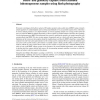Free Online Productivity Tools
i2Speak
i2Symbol
i2OCR
iTex2Img
iWeb2Print
iWeb2Shot
i2Type
iPdf2Split
iPdf2Merge
i2Bopomofo
i2Arabic
i2Style
i2Image
i2PDF
iLatex2Rtf
Sci2ools
CGF
2005
2005
BRDF and geometry capture from extended inhomogeneous samples using flash photography
We present a technique which allows capture of 3D surface geometry and a useful class of BRDFs using extremely simple equipment. A standard digital camera with an attached flash serves as a portable capture device, which may be used to sample geometry to very high resolution, as well as supplying samples over a large portion of the 4D space on which the BRDF is defined. Importantly, it allows capture of extended samples which may have spatially varying (inhomogeneous) BRDF. We demonstrate the system by capturing the geometry of complex materials with varying albedo and BRDF. We show in-situ capture of materials such as a brick wall and a human hand. The limitations of the system are that samples should be roughly planar, and that the BRDF should have some diffuse component in order that a first approximation to the normals can be computed. However, given the simplicity and ease of use of the system (it takes a few minutes to carefully capture a hand), and the ability to capture extend...
| Added | 15 Dec 2010 |
| Updated | 15 Dec 2010 |
| Type | Journal |
| Year | 2005 |
| Where | CGF |
| Authors | James A. Paterson, David Claus, Andrew W. Fitzgibbon |
Comments (0)

